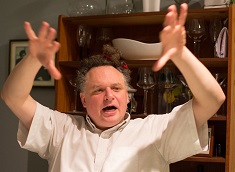“What is a woman?” has become an effective refrain for opponents of Genderwang to bust out in public hearings, townhalls, etc. to wrong-foot progressives. Progressives are reluctant to reiterate what the laws they proclaim say on the subject which is “any person who says ‘I am a woman’ at any time, at any place and for any reason.”
Certainly, women have born the brunt of a lot of terrible progressive legislation concerning freedom of assembly, movement, association and speech. They have been locked in prison cells with serial rapists, made to compete against men in the boxing ring, had the violent abusers they were fleeing admitted to their women’s refuge, forced to receive strip searches and personal nursing from men cosplaying as women. The list goes on. It is well-rehearsed.
Ultimately, the progressive idea seems to be that the ways our bodies and minds have been shaped to meet our species’ reproductive needs is unfair and, therefore, somehow untrue or is something that we can and should cause to be untrue. I would argue that such an enterprise only becomes reasonable in a society in which reproduction, itself, is, as the queer theorists would say, “de-normalized” and “de-centred.”
And at no time is this more evident to me than during my two favourite childhood holidays, Christmas and Hallowe’en. The shift of annual gift-giving from New Years to Christmas and the rise of Hallmark and the greeting card industry in the 1840s, radiating out from the US, followed by the collaborative Anglo-American invention of the modern Santa Claus at the end of the nineteenth century created a whole new deity and ritual practice for a novel secular liberal Christmas.
Hallowe’en, which arose from new forms of consumption and settlement, enabled by the decline of sugar prices with the rise of the sugar beet industry in the American Southwest and the rise of row house streetcar suburbs was, similarly, a new festival and one which, like the new Christmas moved the centre of celebration and observance from otherworldly miracles to the miracle of childhood.
There were a few reasons for this shift, not least a rapidly expanding industry producing packaged sweets, fueled by massive increases in sugar supply and declines in price as American maize and beets produced a sectoral import substitution boom, a new industry in greeting cards and the rise of urban department stores, supplanting the catalogue distributorship model.
But there were also social needs to be met. The growth of the suburbs, the immigration boom, increasingly fueled by Eastern and Southern Europeans, meant that a whole new ethos of neighbourliness had to be built. Hallowe’en was an ideal mechanism for conscripting previously unconnected people into a neighbourly activity through dynamics of pressure and shame, as well as children’s enthusiasm, in that it also allowed them to be vetted based on their treatment of neighbour children. And by inserting a strain of benign paganism, Hallowe’en could also be used to vet for civic-minded religious tolerance.
In a way, child-centred Hallowe’en was to the neighbourly culture in which I grew up, in which my mom borrowed and lent butter, flour and sugar with the other women on our block, what the hajj was to medieval Islam. Mall Santa, I would contend, functioned in a similar way: no one would look too askance on a family that missed going to church on the twenty-fourth or twenty-fifth, to the extent that it was even appropriate to inquire about such things across denomination. But Mall Santa, the closest thing we have to the eponymous priest class of Pharaonic Egypt: that was the pilgrimage that every family had to make. A child could miss Jesus’ intercessory and redemptive sacrifice but not the materialist confession they made on the lap of a portly man who resembled more a medieval imagining of a man possessed by Mammon than the Saint Nicholas who punched Arius in the face at the Council of Nicea and whose bones Recep Erdogan has offered to sell us.
But worry was also a big part of what generated these rituals, twin demographic anxieties nearly identical to our own. Strange how when wealth rapidly polarizes and demand is fueled and maintained by massive increases in consumer debt leavened by increasingly conscriptive monthly instalment plans, people seem to decide that the solution is more cross-dressing and immigration. But of course, rapid, unsustainable rates of immigration were, just as they are today, part of the Global North’s strategy for maintaining increasingly precarious economic growth by creating shortages of jobs and housing, pushing down wages and pushing up rents.
The immigration increases were justified much as they are today, white Protestant birth rates were declining and, to maintain the constant growth capitalism demands, more migrants were necessary. Teddy Roosevelt propounded a natalist policy in response, seeking to ban contraception and create new incentives for families to have kids. We often mistake the “baby bonus,” like the public school system as a proto-welfare state policy that a party like Germany’s Social Democrats might introduce. But these policies are the sort we see coming out of the natalist governments of Viktor Orban and Jean-Francois Legault today. You see: public schools and baby bonuses were originally understood in natalist terms i.e. they were created because the state believed people should have more kids and sought to make that easier; they did not arise from a belief in universals material entitlements of minors to education or to clothing and shelter.
Ultimately, child-centred festivals addressed these anxieties, to an extent, in a number of ways. They had an assimilating effect on communities by conscripting them into universal activities through their children, dampening worries about immigration; both local Anglo creoles and newcomers were creating new shared civic rituals together; they helped to build trust and vetting processes for neighbours’ suitability to look out for free range kids, enabling the world of Our Gang and the Little Rascals to come into being.
The New Deal Order was only around for little more than half a century. It was largely sustained by the rise of the Soviet Union and East Bloc. Without them, there is simply no reason it was rational to keep that social contract around. It had served its purpose and won the Cold War. And universal material guarantees could be safely scaled-back.
And so, not just the material supports but the cultural and infrastructural supports for parents were stripped away. Instead of focusing gifting primarily on children and secondarily on other relatives at Christmas time, the idea of a nebulously-defined self-selected “family” of friends was relentlessly popularized in media, entertainment and popular psychology, making who was to receive a gift less clear and more fraught with anxiety likely to produce over-purchasing. Besides, with their knowledge and expectations, adults tend to prefer more expensive gifts. It made good money, good sense to replace a child and family-structured Christmas with voluntarist liberal associational Christmas.
The changes in Hallowe’en I found personally upsetting. I watched the festival from one centred on children to one centred on twentysomethings and then on adults in early middle age. It took me decades to outrun the damn thing. Every time I thought Hallowe’en parties would become age-inappropriate in my circle and stop being major events, they suddenly became age-appropriate for even older people, again a move relentlessly pushed by popular media.
Furthermore, as laws and the culture of the caring professions shifted in a more individualistic, neoliberal direction, on the one hand, and, on the other became gripped by an irrational safetyism that sought to shut down the very idea of free range kids, the Hallowe’en’s hajj-like properties declined. Instead of being a block-based processional festival, individual children were driven, by their parents, to the homes of trusted, pre-vetted people. Childless newcomers to neighbourhoods ceased putting out decorated pumpkins and buckets of candy. And so the integrative and vetting functions, crucial to the maintenance of neigbhourliness, disappeared. In its place were parties focusing on novel and fantastical forms of display by young women as wire-fu, manga and superheroines came to define new fads in my generation’s male sexual imaginary.
But today, on our streets, it is not young women with blue hair and shiny clothes that are exotic. Free range children sent to the Safeway to buy extra tomatoes, unsupervised kids on buses, kids on bikes: these are the surprising and transgressive sight of this society. Free range kids are not just a scary verging on impossible idea for us because we no longer vet our neighbours and there are no more “block parent” signs in houses’ windows.
They challenge us because we no longer believe that an adult behaving as an adult is an essential part of the social contract. When you live in a society where people have no experience of children, who have had their natural instincts to care and look out for kids beaten out of them, who believe not that a child is a protected class of person but that being a child is a right. Only a society that thinks about childhood as a privilege or right to which they can subscribe, that a person can pick up or put down, would verb the word “adult” and congratulate themselves on social media for “adulting” that day. Of course, this is a society that is engaged in trying to tell us that the “adult baby” fetish is benign.
Similarly to womanhood, childhood is being transformed from a particular embodied location in the human reproductive and developmental process into a feeling, a state of mind. How else can we explain our government’s insistence that children as young as twelve can and should obtain lethally dangerous drugs like Lupron and Fentanyl, behind their parents’ backs and at state expense? How else do we explain fifty-two-year-old York University professor Nicholas Cepeda being permitted to participate in middle school girls’ swim meets and wave his dick at the twelve-year-old girls in the locker room? His right to be a child trumps their right to experience the protections normally granted to children, just as his right to be a woman does.
While Cepeda is an outlier—although not as much of one as you might hope if you read the news on Reduxx—his entitlement speaks to where our horizon of possibilities has gone as our contact with children and, relatedly, our experience of age-appropriate behaviour has steadily declined over the course of my adult life.
It is not that progressive Canadian society has some sinister idea of what a child is, exactly. It is that it has absolutely no idea what a child is. And if you don’t know what a woman is, you can’t protect women. And if you don’t know what a child is, you can’t protect children.
In the crescendo of Tom Waits’1980s surrealist auctioneer song, Step Right Up, Waits chants “It turns a sandwich into a banquet / Tired of being the life of the party? / Change your shorts! Change your shorts! Change your life! / Change into a nine-year-old Hindu boy and get rid of your wife!”
Now that’s an option, a present you can buy yourself for Christmas after a hard year adulting.

